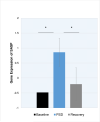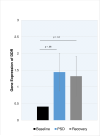Partial sleep deprivation activates the DNA damage response (DDR) and the senescence-associated secretory phenotype (SASP) in aged adult humans - PubMed (original) (raw)
Partial sleep deprivation activates the DNA damage response (DDR) and the senescence-associated secretory phenotype (SASP) in aged adult humans
Judith E Carroll et al. Brain Behav Immun. 2016 Jan.
Abstract
Age-related disease risk has been linked to short sleep duration and sleep disturbances; however, the specific molecular pathways linking sleep loss with diseases of aging are poorly defined. Key cellular events seen with aging, which are thought to contribute to disease, may be particularly sensitive to sleep loss. We tested whether one night of partial sleep deprivation (PSD) would increase leukocyte gene expression indicative of DNA damage responses (DDR), the senescence-associated secretory phenotype (SASP), and senescence indicator p16(INK4a) in older adult humans, who are at increased risk for cellular senescence. Community-dwelling older adults aged 61-86years (n=29; 48% male) underwent an experimental partial sleep deprivation (PSD) protocol over 4 nights, including adaptation, an uninterrupted night of sleep, partial sleep deprivation (sleep restricted 3-7AM), and a subsequent full night of sleep. Blood samples were obtained each morning to assess peripheral blood mononuclear cell (PBMC) gene expression using Illumina HT-12 arrays. Analyses of microarray results revealed that SASP (p<.05) and DDR (p=.08) gene expression were elevated from baseline to PSD nights. Gene expression changes were also observed from baseline to PSD in NFKB2, NBS1 and CHK2 (all p's<.05). The senescence marker p16(INK4a) (CDKN2A) was increased 1day after PSD compared to baseline (p<.01), however confirmatory RT-PCR did not replicate this finding. One night of partial sleep deprivation activates PBMC gene expression patterns consistent with biological aging in this older adult sample. PSD enhanced the SASP and increased the accumulation of damage that initiates cell cycle arrest and promotes cellular senescence. These findings causally link sleep deprivation to the molecular processes associated with biological aging.
Keywords: Cellular aging; DNA damage; Gene expression; Inflammation; Older adults; Senescence; Sleep deprivation.
Copyright © 2015 Elsevier Inc. All rights reserved.
Figures
Figure 1. Gene expression of the senescence associated secretory phenotype (SASP) at baseline, partial sleep deprivation (PSD), and one day after PSD (Recovery) in older adults
SASP is a composite score created from a sum of 9 z-transformed genes. Error bars represent standard error of estimated marginal mean, adjusting for
BMI and sex
. *p<.05
Figure 2. Gene expression of the DNA damage response (DDR) at baseline, partial sleep deprivation (PSD), and one day after PSD (Recovery) in older adults
DDR is a composite score created from a sum of 30 z-transformed genes. Error bars represent standard error of estimated marginal mean,
adjusting for BMI and sex
.
Figure 3
Proposed molecular pathways promoting aging after sleep deprivation.
Similar articles
- Lifetime chronic stress exposures, stress hormones, and biological aging: Results from the Midlife in the United States (MIDUS) study.
Hansen JL, Carroll JE, Seeman TE, Cole SW, Rentscher KE. Hansen JL, et al. Brain Behav Immun. 2025 Jan;123:1159-1168. doi: 10.1016/j.bbi.2024.10.022. Epub 2024 Oct 22. Brain Behav Immun. 2025. PMID: 39442637 - Sleep deprivation and divergent toll-like receptor-4 activation of cellular inflammation in aging.
Carroll JE, Carrillo C, Olmstead R, Witarama T, Breen EC, Yokomizo M, Seeman T, Irwin MR. Carroll JE, et al. Sleep. 2015 Feb 1;38(2):205-11. doi: 10.5665/sleep.4398. Sleep. 2015. PMID: 25325509 Free PMC article. - Folic Acid Supplementation Suppresses Sleep Deprivation-Induced Telomere Dysfunction and Senescence-Associated Secretory Phenotype (SASP).
Zhang X, Wang Y, Zhao R, Hu X, Zhang B, Lv X, Guo Z, Zhang Z, Yuan J, Chu X, Wang F, Li G, Geng X, Liu Y, Sui L, Wang F. Zhang X, et al. Oxid Med Cell Longev. 2019 Dec 14;2019:4569614. doi: 10.1155/2019/4569614. eCollection 2019. Oxid Med Cell Longev. 2019. PMID: 31949878 Free PMC article. - Keeping the senescence secretome under control: Molecular reins on the senescence-associated secretory phenotype.
Malaquin N, Martinez A, Rodier F. Malaquin N, et al. Exp Gerontol. 2016 Sep;82:39-49. doi: 10.1016/j.exger.2016.05.010. Epub 2016 May 25. Exp Gerontol. 2016. PMID: 27235851 Review. - DNA damage response (DDR) and senescence: shuttled inflamma-miRNAs on the stage of inflamm-aging.
Olivieri F, Albertini MC, Orciani M, Ceka A, Cricca M, Procopio AD, Bonafè M. Olivieri F, et al. Oncotarget. 2015 Nov 3;6(34):35509-21. doi: 10.18632/oncotarget.5899. Oncotarget. 2015. PMID: 26431329 Free PMC article. Review.
Cited by
- Metabolomics in Sleep, Insomnia and Sleep Apnea.
Humer E, Pieh C, Brandmayr G. Humer E, et al. Int J Mol Sci. 2020 Sep 30;21(19):7244. doi: 10.3390/ijms21197244. Int J Mol Sci. 2020. PMID: 33008070 Free PMC article. Review. - Effects of the dual orexin receptor antagonist DORA-22 on sleep in 5XFAD mice.
Duncan MJ, Farlow H, Tirumalaraju C, Yun DH, Wang C, Howard JA, Sanden MN, O'Hara BF, McQuerry KJ, Bachstetter AD. Duncan MJ, et al. Alzheimers Dement (N Y). 2019 Feb 28;5:70-80. doi: 10.1016/j.trci.2019.01.003. eCollection 2019. Alzheimers Dement (N Y). 2019. PMID: 30859123 Free PMC article. - At the forefront of psychoneuroimmunology in pregnancy: Implications for racial disparities in birth outcomes: PART 2: Biological mechanisms.
Christian LM. Christian LM. Neurosci Biobehav Rev. 2020 Oct;117:327-333. doi: 10.1016/j.neubiorev.2019.03.010. Epub 2019 Mar 15. Neurosci Biobehav Rev. 2020. PMID: 30885813 Free PMC article. Review. - Hypertension and cellular senescence.
Afsar B, Afsar RE. Afsar B, et al. Biogerontology. 2023 Aug;24(4):457-478. doi: 10.1007/s10522-023-10031-4. Epub 2023 Apr 3. Biogerontology. 2023. PMID: 37010665 Review. - Altered sleep and inflammation are related to outcomes in neonatal encephalopathy.
Hurley T, Stewart P, McCarthy R, O'Dea M, Kelly L, Daly M, Butler J, McCarthy R, Miletin J, Sweetman D, Byrne A, Colleran G, Bhroin MN, Bokde ALW, Molloy EJ. Hurley T, et al. Acta Paediatr. 2025 Feb;114(2):428-436. doi: 10.1111/apa.17457. Epub 2024 Nov 5. Acta Paediatr. 2025. PMID: 39498720 Free PMC article.
References
- Ohayon MM. Epidemiology of insomnia: what we know and what we still need to learn. Sleep Med Rev. 2002;6(2):97–111. doi:10.1053/smrv.2002.0186. - PubMed
- Petit L, Azad N, Byszewski A, Sarazan FF- A, Power B. Non-pharmacological management of primary and secondary insomnia among older people: review of assessment tools and treatments. Age Ageing. 2003;32(1):19–25. - PubMed
- Foley DJ, Monjan AA, Brown SL, Simonsick EM, Wallace RB, Blazer DG. Sleep complaints among elderly persons: an epidemiologic study of three communities. Sleep. 1995;18(6):425–32. - PubMed
- McEwen BS. Sleep deprivation as a neurobiologic and physiologic stressor: Allostasis and allostatic load. Metabolism. 2006;55(10 Suppl 2):S20–3. doi:10.1016/j.metabol.2006.07.008. - PubMed
Publication types
MeSH terms
Grants and funding
- UL1TR000124/TR/NCATS NIH HHS/United States
- R01 DA032922/DA/NIDA NIH HHS/United States
- UL1 TR000124/TR/NCATS NIH HHS/United States
- T32 MH019925/MH/NIMH NIH HHS/United States
- R01 CA160245/CA/NCI NIH HHS/United States
- P30 AG028748/AG/NIA NIH HHS/United States
- P30 AG017265/AG/NIA NIH HHS/United States
- R01 AG034588/AG/NIA NIH HHS/United States
- K01 AG044462/AG/NIA NIH HHS/United States
- R01 AG026364/AG/NIA NIH HHS/United States
- R01 HL095799/HL/NHLBI NIH HHS/United States
LinkOut - more resources
Full Text Sources
Other Literature Sources
Medical
Research Materials
Miscellaneous


